Latin American Street Food The Best Flavors of Markets, Beaches, and Roadside Stands from Mexico to Argentina
Latin American Street Food takes cooks on a tasting tour of the most popular and delicious culinary finds of twenty Latin American countries, including Mexico, Cuba, Peru, and Brazil, translating them into 150 easy recipes for the home kitchen.
From tamales to tacos, food on a stick to ceviches, and empanadas to desserts, Sandra A. Gutierrez’s Latin American Street Food takes cooks on a tasting tour of the most popular and delicious culinary finds of twenty Latin American countries, including Mexico, Cuba, Peru, and Brazil, translating them into 150 easy recipes for the home kitchen. These exciting, delectable, and accessible foods are sure to satisfy everyone.
Sharing fascinating culinary history, fun personal stories, and how-to tips, Gutierrez showcases some of the most recognized and irresistible street foods, such as Mexican Tacos al Pastor, Guatemalan Christmas Tamales, Salvadorian Pupusas, and Cuban Sandwiches. She also presents succulent and unexpected dishes sure to become favorites, such as Costa Rican Tacos Ticos, Brazilian Avocado Ice Cream, and Peruvian Fried Ceviche. Beautifully illustrated, the book includes a list of sources for ingredients.
Sandra A. Gutierrez, who grew up in the United States and Guatemala, is a food writer, culinary instructor, and recipe developer. She is author of The New Southern-Latino Table: Recipes That Bring Together the Bold and Beloved Flavors of Latin America and the American South. She lives in Cary, N.C.
“Offers a glimpse of the variety of food that ended up being sold on streets from Lima, Peru, to Mexico City.”
–Raleigh News & Observer
“The book is packed with surprises. . . [and] many appealing recipes, a great adventure.”
–Kitchen Arts and Letters
“Contemporary, hip, and full of recipes for less-recognized but deeply loved dishes, Latin American Street Food samples the flavor and range of street foods while guiding readers of varying ages and skill sets.”
–Norman Van Aken, co-author of My Key West Kitchen: Recipes and Stories
Tuna Ceviche
Poblano and Cheese Quesadillas (Quesadillas de Rajas)
Costa Rican Tacos Ticos
Chocolate-Covered Bananas (Chocobananos)
Refreshing, low-fat ceviches such as this one are very easy to make, and this one can be assembled in no time. This ceviche is particularly festive because it’s so pretty and colorful. If you eat it as a first course, serve it with corn nuts, plantain, or saltine crackers. For a main course salad, eat it the way Peruvians do: with boiled sweet or yellow potatoes, to soak up the sour marinade. I love to serve this ceviche in well-chilled martini glasses, to showcase all of the colors. Use only the highest quality, sashimi-grade tuna for this recipe. For an impressive appetizer, serve spoonfuls of this ceviche on the ends of endive leaves. It’s simple, pretty, and fun.
Serves 8 as an appetizer or 4 as a main course
- 1 ½ pounds fresh, sashimi-grade tuna, cut into ¼-inch dice
- 1 ½ cups fresh lime juice
- ½ cup minced roasted red bell pepper
- ½ cup minced cilantro (leaves and tender stems)
- ½ cup seeded and minced plum tomatoes
- 1/3 cup minced red onion
- ¼cup minced jalapeño peppers (seeded and deveined if less heat is desired)
- ¼ cup minced chives
- Salt and freshly ground black pepper, to taste
In a large nonreactive bowl (preferably glass), combine the tuna, lime juice, bell peppers, cilantro, tomatoes, onions, jalapeños, and chives; stir well to combine. Cover with plastic wrap and chill for 1 hour (up to 4 hours). Season with salt and pepper and serve well chilled.
Poblano and Cheese Quesadillas (Quesadillas de Rajas)
I had to include at least one recipe for the ubiquitous Mexican grilled cheese sandwich that has taken the fast-food world by storm in the last two decades. Queso (cheese) gives these stuffed tortillas the gooey characteristic that we all love. Quesadillas can be filled with virtually anything you like (see note), but chiles and cheese are traditional fare in Mexico. Poblanos are long, dark-green peppers. Their skins are quite tough and they’re seldom eaten raw. Roasting them makes them easy to peel and softens their flesh; they’re not too spicy, although some can be hotter than others. Any melting cheese works well in quesadillas, and if you’re lucky to find good Mexican cheese such as Oaxaca, by all means use it. However, my friend Diana Kennedy, who is an authority in Mexican cuisine and a cookbook author, taught me that domestic Muenster melts similarly to the cheeses used in Mexico, so I use it here. Top these with Raw Tomatillo Salsa (recipe in book), Avocado-Tomatillo Taco Truck Sauce (recipe in book), or Sweet Dried Chile Sauce (recipe in book).
Serves 8
- 4 roasted poblano peppers, peeled, seeded, deveined, and sliced into thin strips
- 8 (8-inch) flour tortillas
- 12 ounces Muenster cheese, thinly sliced
- 8 ounces soft goat cheese, crumbled
- ¼ cup thinly sliced green onions (white and green parts)
- Vegetable oil (for brushing on tortillas)
- Mexican crema (optional)
Place the tortillas on a flat surface. Top the bottom half of each tortilla with Muenster cheese, poblano strips, crumbled goat cheese, and green onions. Fold the tortillas in half, to enclose the filling.
Heat a griddle or nonstick pan over medium-high heat; brush the top mof the quesadillas with oil and place them on the griddle, oil side down. Cook the quesadillas until one side is golden and crispy, about 1–2 minutes (rotating them as they cook will prevent them from burning before the cheese has a chance to melt); brush the tops with a bit of oil and turn them over to cook on the other side until they’re golden and crispy and until the cheese has melted, about 1–2 minutes.
Cut the quesadillas in half; top with your favorite salsa and drizzle with crema (if using). Serve immediately.
NOTE: Possible fillings include any good melting cheese and the chorizo and potato filling for sopes (recipe in book), Refried Black Beans (recipe in book), the chicken filling for Tostadas with Spicy Chicken (recipe in book), or the Beef Picadillo (recipe in book).
Costa Rican Tacos Ticos
I like to call these happy tacos because it’s impossible not to laugh out loud when trying to eat them. Corn tortillas stuffed with shredded beef are fried until crispy and then topped with whimsical ingredients. I use leftover beef from my cocido (page 000) and Handmade Corn Tortillas. Of course, you can use store-bought corn tortillas if you wish. The toppings are what make these so much fun to eat: first, a generous amount of shredded cabbage, and then the real enjoyment begins when they’re drizzled with ketchup, mustard, and mayonnaise. I know it sounds funny to use the same condiments you’d usually reserve for hot dogs, but they really work! In Costa Rica, tacos ticos are served either singly or in pairs (called dobles) and are wrapped in plastic squares. If you’re planning a taco party, fry the tacos ahead of time and keep them warm in a 250°F oven, for up to 1 hour. Place the condiments in squirt bottles and let everyone assemble and top them as they like.
Makes 12 tacos
- 5 cups shredded cabbage
- 1 ½ teaspoons salt
- 2 ½ cups leftover meat from the cocido (recipe in book) or other cooked and shredded beef (see note)
- 12 Handmade Corn Tortillas (recipe in book) or store-bought, warm (see note)
- 12 (8-inch-long) pieces kitchen twine
- Vegetable oil for frying
- Ketchup
- Mustard
- Mayonnaise
Place the cabbage in a large bowl; add enough boiling water to cover and let it sit for exactly one minute. Drain the cabbage well and return it to the bowl. Add the salt and stir; let it sit at room temperature for 30 minutes or until cool. Cover and chill for up to 24 hours.
Working with one tortilla at a time, place 2–3 tablespoons of the shredded beef on one end of it and roll it up tightly, like a cigar (it has to be tight or the beef will escape when the tacos are fried). Tie it snuggly with a piece of twine and set aside; repeat with the remaining tortillas and filling.
Fit a large baking pan with a metal cooling rack; set aside. In a large skillet with high sides, heat 1–2 inches of oil to 360°F (or use a deep fryer according to the manufacturer’s directions). Working in batches, use tongs to place the tacos in the oil. Fry them until golden, about 3–3 ½ minutes, turning them over halfway through. Transfer them to the prepared rack to drain.
To plate, place two tacos on a plate, top with a generous amount of the cabbage, and drizzle with the condiments. Serve immediately.
NOTE: If you don’t want to make the cocido, simply boil a 1-pound piece of beef roast or flank steak in salted water until it’s cooked through. Cool and shred. Shredded rotisserie chicken works well, too.
To prevent corn or flour tortillas from breaking when folded or rolled, heat them briefly. To do this, wrap several tortillas in a clean, damp kitchen towel; microwave at 1-minute intervals until they are warm. Alternatively, wrap them in foil and place them in a preheated 350°F oven for 10–15 minutes. You can also heat them, one at a time, directly over a flame of a gas stove (or an outdoor grill) for 20 seconds on each side. Keep the warm tortillas wrapped in a kitchen towel as you work. It’s a good idea to have a few extra tortillas in case some break as the tacos are shaped.
Chocolate-Covered Bananas (Chocobananos)
Many Latin American kids have experienced the pleasure of eating a perfectly frozen banana, coated in silky chocolate, and sprinkled with toppings. As a child, I could buy them from ice cream trucks. I made these often when my kids were little; now that they are all grow up, I still make them for myself. It’s important to freeze the bananas very well so that they’re sturdy when you dunk them into the chocolate; if they aren’t frozen solid, they’ll break into pieces. Once frozen, work swiftly—the chocolate sets quickly after they’re dipped. I’m told these keep well in the freezer for a few months, but I wouldn’t know because, in my home, they’re devoured immediately.
Serves 8
- 4 ripe but firm bananas, peeled and cut in half crosswise
- 8 popsicle sticks
- 12 ounces semisweet chocolate, chopped
- 1 cup flaked coconut
- 1 cup finely chopped unsalted roasted peanuts
Line a baking sheet with parchment paper. Insert a popsicle stick into each banana half; place them on the prepared sheet (so they aren’t touching each other). Freeze them until solid (for at least 3 hours up to 3 days).
Melt the chocolate on top of a double boiler over very low heat, stirring until smooth. Dip the frozen bananas into the chocolate; working quickly (or the chocolate will set), sprinkle one side of the banana with coconut and the other side with peanuts. Place the bananas back on the prepared sheet and freeze them again for 10–20 minutes before serving. Once frozen solid, these will keep well in a freezer-safe container or bag for up to 3 months.
From LATIN AMERICAN STREET FOOD: THE BEST FLAVORS OF MARKETS, BEACHES, AND ROADSIDE STANDS FROM MEXICO TO ARGENTINA by Sandra A. Gutierrez. Copyright © 2013 by Sandra A. Gutierrez. Used by permission of the University of North Carolina Press


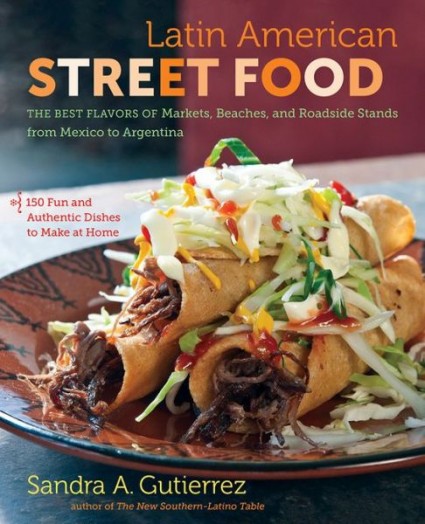






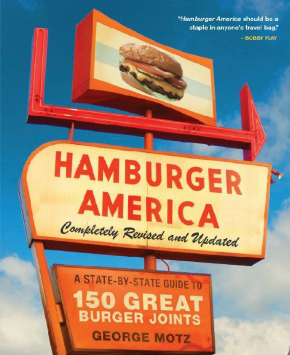
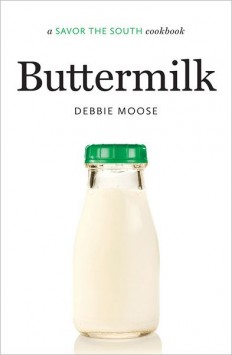


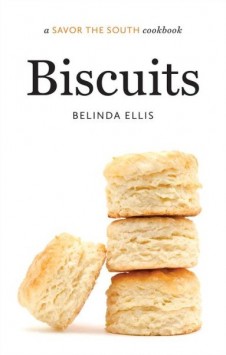
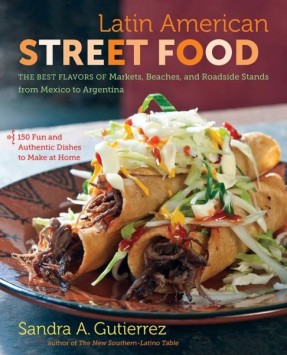
Leave a Reply